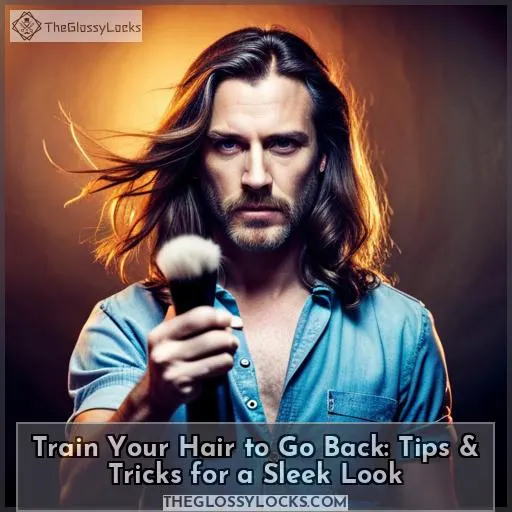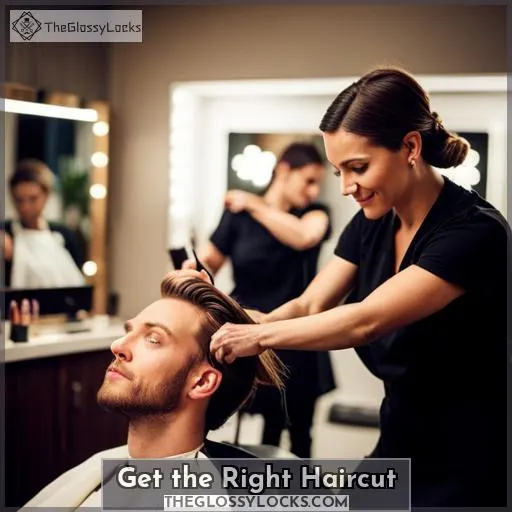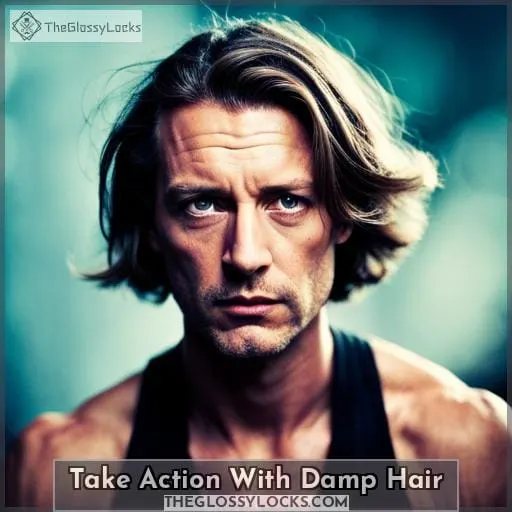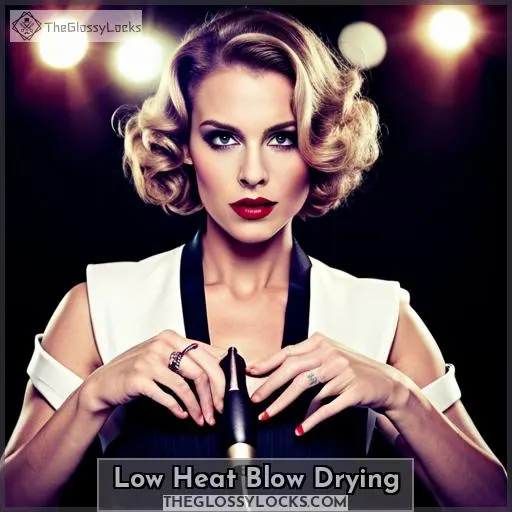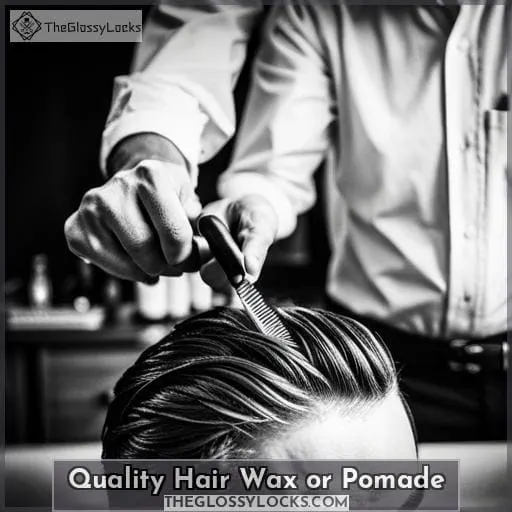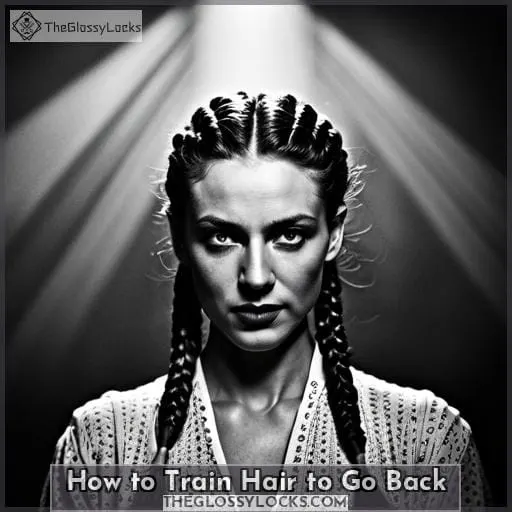This site is supported by our readers. We may earn a commission, at no cost to you, if you purchase through links.
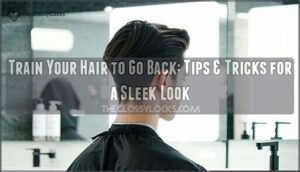 Bored of your hair not staying back? Ready to become the envy of all with a sleek, slicked-back look that lasts all day? You’re in luck! With the right cut and styling techniques, you can learn how to train your hair to go back.
Bored of your hair not staying back? Ready to become the envy of all with a sleek, slicked-back look that lasts all day? You’re in luck! With the right cut and styling techniques, you can learn how to train your hair to go back.
Whether you’re looking for an everyday style or want something special for an upcoming event, these tips will help you get that perfect slick-back look. Start by getting a haircut tailored specifically towards this style. Then, use mindful length maintenance coupled with damp action backcombing and low heat blow drying.
Follow this up with quality wax or pomade application and use accessories such as clips or bands (where appropriate).
All it takes is patience, but training your hair does not have to be hard work if done correctly. Brush or comb while showering on lower settings using products effectively so they don’t weigh down locks too much.
Table Of Contents
- Key Takeaways
- Get the Right Haircut
- Mindful Hair Length
- Take Action With Damp Hair
- Low Heat Blow Drying
- Daily Backward Combing
- Quality Hair Wax or Pomade
- Right Hair Accessories
- Style With Serum
- Can Hair Training Be Done?
- How to Train Hair to Go Back
- Frequently Asked Questions (FAQs)
- How often should I get my hair cut to train it to go back?
- What is the best length for my hair to be trained to go back?
- How long does it take to train my hair to go back?
- Are there any special products I should use to train my hair to go back?
- Can I train my hair to go back if I have a particular hairstyle or texture?
- Conclusion
Key Takeaways
- Get a tailored haircut for the sleek, slicked-back look.
- Use quality hair wax or pomade and accessories like clips or bands.
- Use wide-toothed combs and heat protection sprays to protect against breakage and damage.
- Incorporate hair training into regular grooming routines and understand the role of hair training in controlling different hairstyles.
Get the Right Haircut
You can get the perfect look by getting a haircut that complements your features, emphasizing them with clever use of alliteration. Choosing the right style for you is key to training your hair to go back into place.
Consider your own hair texture and type when selecting a cut as this will have an impact on how much styling effort it takes to achieve desired results. Understanding how fast or slow your hair grows is also important so that regular trims keep split ends in check and allow for healthy growth.
Getting professional advice from experienced stylists may help ensure better end-results before investing too much time at home trying various cuts yourself! To further train longer styles, avoid excessive product use on already weakened follicles; instead, opt for wide-tooth combs which are gentler but still effective in smoothing tresses without damaging them more than necessary – always aiming towards healthier-looking locks!
With proper care and attention, having a great-looking hairstyle won’t be such a challenge after all – simply choose one tailored specifically for you according to individual needs & preferences while being mindful not to overdo any treatments or products used along the way…and soon enough even those wildest curls can become easy everyday looks!
Mindful Hair Length
Work with what you have – mindful hair length is key to getting the look you want. When it comes to maintaining your locks, paying attention to how long or short they are can make all the difference in making sure that style stays put.
Different hair types require different approaches when considering length retention. For example, straight hair types may need more frequent trims due to their tendency towards a faster growth rate compared with other textures.
Heat protection should also be factored into any haircare routine as well, since high temperatures can damage strands of hair over time and lead them away from their desired shape! Additionally, using quality pomade and wide-toothed combs instead of brushes will help protect against breakage while still allowing for maximum styling potential – ultimately creating a good cut that not only looks great but lasts longer too!
With these tips in mind, combined with regular maintenance practices such as deep conditioning treatments or sulfate-free shampoos at least once per week (or as recommended by professional stylists), anyone can achieve healthier-looking locks and keep them looking fabulous day after day… allowing freedom & control like never before!
Take Action With Damp Hair
Start styling your damp hair with the correct tools to create and maintain the perfect look! Hair length management is essential for achieving a long-lasting style.
Begin by brushing wet locks daily with a wide-toothed comb to detangle any knots without damaging them. Afterward, use heat protection sprays before blow-drying on low settings or applying flat irons at medium temperatures.
When it comes time for product application, consider using glossing serums or light mousses that can provide extra shine while also helping seal in moisture so dry ends stay hydrated.
Overall, taking care of one’s mane doesn’t have to be complicated or expensive. All you need are some key tips & tricks plus invest in quality items that suit your specific needs best. For example, finding an air diffuser attachment specifically designed for curly textures helps define curls much better than traditional methods do.
With these steps followed faithfully every day, along with regular trims when necessary, anyone can have beautiful, healthy-looking hair no matter what their texture is like.
Low Heat Blow Drying
When blow drying, use low heat settings to maintain healthy-looking locks without damaging them – and why not ask yourself, Am I using the right tools for my hair?
It is important to select products that will work with your unique hair texture. For example, wax-like substances are not ideal if you have thin or fine strands as they can weigh down the roots, resulting in further loss of volume.
A boar bristle brush is great for creating smoothness when used on medium temperature heat settings, while a flat iron should be used at its lowest setting when styling curly textures!
Once you’ve decided upon what product works best for your type of hair, start by prepping damp tresses with a light moisturizer before applying any other serums or mousses.
To get optimal results without causing unnecessary harm, use only low heat levels instead of traditional sense.
So break away from heated damage & embrace natural beauty today by taking action now; invest in quality items suitable specifically for your needs, plus follow these simple tips consistently every day – then watch how quickly long-lasting styles become achievable like never before!
Daily Backward Combing
Daily combing your hair backwards can provide the perfect foundation for achieving a long-lasting style without heat damage.
Next, use parting techniques to divide sections of hair and apply a small amount of pomade or wax to each section as needed. For added protection against heat, consider investing in some quality scalp care products such as oils or spray mists that help create an extra layer between your locks and any heated tools you may be using afterwards (such as curling irons).
Finally, brushing techniques are key when creating smoothness; use gentle strokes from root-to-tip while going in the opposite direction than normal – always start with lower temperatures & gradually increase if necessary until desired results are achieved! With these simple steps combined with daily backward combing sessions done right, it won’t take long before those luscious locks become perfectly tamed – minus all the damaging consequences associated with traditional hot air drying practices.
Quality Hair Wax or Pomade
Tame your mane and keep it in place with quality hair wax or pomade – don’t let those locks get out of control!
For the best results, start by shampooing regularly to ensure follicles are clean and free from product buildup. To create a good foundation for styling, you’ll also need to pay attention to scalp care.
Divide sections of hair before applying a small amount of high-quality product into each section as needed.
It’s important that your choice is tailored towards your own unique hair type. If unsure what kind works best for yours, then speak with an experienced stylist who can guide you down the right path according to individual needs and preferences!
Even though heat protection isn’t necessary when combing backwards, adding in some lightweight hairspray after brushing could be helpful too. Just make sure not to tie up tresses tightly afterwards since this may cause breakage if done frequently enough.
A good final step would be investing in some quality accessories such as clips or bands.
With these simple steps combined together, having well-trained locks won’t seem like such an impossible feat anymore.
Right Hair Accessories
Complete your look with the right hair accessories to keep those locks in place and wow everyone around you! Styling techniques, heat protection, barrettes, clips, and styling tools – all of these can play a part when it comes to training your tresses.
When selecting products for this purpose, pay attention to both your individual needs as well as product selection.
Remember that the natural direction of hair growth should also be taken into consideration while applying just the right amount of product needed so as not to overload on greasy home items. A small amount is usually enough if there’s enough length available in each section before attempting styling attempts towards the desired outcome, regardless of what type yours truly might have been blessed with.
Barrettes are great options when trying out different up-dos, but don’t forget about incorporating some lightweight hairspray afterwards either – especially if looking at holding shape all day long without having damaging consequences associated with traditional hot air drying practices!
With these simple steps combined together, success will come easy and soon no one else will even know how much effort was really involved behind pulling off such sophisticated looks every single time!
Style With Serum
Fight frizz and flyaways with a few drops of serum! Using just the right amount can make all the difference in achieving a sleek style that’ll last you hours on end.
When it comes to training your hair to go back, combing techniques are key. To avoid breakage or damage, heat protection products such as hairspray or gel should be applied beforehand if necessary. Additionally, selecting products catered towards particular growth patterns is important.
It’s equally important to not only find easy ways to incorporate into regular grooming routines but also understand its role in keeping things under control at all times – no matter what type of hairstyle is desired.
From messy buns, curls, braids, and more, there exist many possibilities to achieve without having to resort to harsh treatments like hot air drying, which could potentially harm the scalp in the long run – especially for those already prone to tangling easily.
Can Hair Training Be Done?
It’s no secret that having a good cut is essential for achieving any hairstyle you desire, whether it be curls, braids, or an updo. Proper training of the hair can make all the difference in your look. However, understanding and tailoring to individual growth patterns is key, as this will help avoid breakage or damage from occurring over time.
Hair Growth Patterns
Understanding your hair’s individual growth patterns is essential when it comes to achieving the desired look you’re after. Knowing and understanding your own unique hair texture, hair density, hair type, and volume can help you create styles that are more tailored to what works best for your mane.
Taking a close look at these features gives an accurate snapshot into how specific haircuts will appear on different individuals – making sure results are consistent each time!
The first step in getting familiar with this information is determining which of the four main hair types (straight, wavy/curly/kinky) applies most accurately. Then from there, one can investigate further by exploring variations within those categories—like looking closer into texture or thickness levels as well as observing distinct growth directions throughout the scalp area itself (i.
With all this knowledge gathered together, now everyone else has full control over their tresses – no matter how wild they may be!
Importance of a Good Cut
Getting the perfect cut is essential for styling your hair to its fullest potential. Detangling techniques, split ends, and texture types must be considered when deciding on the best look. Additionally, scalp treatments before and after cuts can help ensure effective results of the hair training process.
Part lines should also be taken into account; they’re just as important as understanding one’s own hair structure!
The importance of a good cut cannot be understated – especially if you want to replicate styles seen in pictures or on celebrities! It’s vital that individuals find a reputable stylist who takes their personal needs seriously when creating new looks for them so that they’ll feel confident with their final result every single time.
Additionally, investing in products catered specifically towards nourishing strands while styling is a crucial step toward achieving successful outcomes from any type of training session done at home or in a salon setting alike!
How to Train Hair to Go Back
Train your hair to go back with ease by following a few simple steps. Start in the shower, brushing or combing through your locks to detangle and set up for styling. After you’re done, take out a low heat blow dryer and be sure to use quality pomade or wax, depending on the desired hairstyle.
Brush or Comb in Shower
Gently detangling your locks in the shower with a brush or comb can help set you up for success when styling your hair. Back brushing, taming, and controlling volume are all key aspects of training it to stay put.
Moisturizing spray is essential, as well as trimming tips to get rid of split ends, while keeping an eye on perfect hair requirements like patterns of growth and desired position.
Low Heat Blow Dryer
Using a low-heat blow dryer can help give your hair the shape and hold you desire without causing too much damage. Be sure to adjust the heat settings based on your hair type, texture, and styling tools used.
Heat protection is essential! Divide portions of the hair into sections while avoiding excessive heat or long hours of drying, which could be damaging for your locks.
Quality Pomade or Wax
Try using a high-quality pomade or wax to shape your hair and keep it in place. Make sure to consistently apply the product and keep your strands hydrated by dry brushing. Choose the appropriate hold for your desired look – if needed, separate strands to achieve a slicked-back style.
The main part of this process should require a minimal amount of time, but it’s important to have a bit of patience when training your hair.
Using Products Effectively
Make sure to use your pomade or wax effectively to shape and hold your style for a lasting look. Gels, styling sprays, and oil products can also help you create the desired texture. Hair clips are helpful too! Use heat protectants before any heat-styling as well.
Consider using different types of products based on hair growth patterns and texture – a small dollop of hair serum may do the trick! The most important rule of thumb is not to overuse product; an incredibly popular hairstyle doesn’t need much product at all.
Finish With Glossing Serum
Finish off your look with a glossy serum to give your style the perfect shine and texture. Routine maintenance, moisturizing tips, damage prevention, and protective styling will be key in achieving immaculate hair.
Haircare products can also help guide you in different directions; using them correctly is often the best bet for long-term results.
Frequently Asked Questions (FAQs)
How often should I get my hair cut to train it to go back?
Getting your hair cut regularly is key to training it to go back. Start with a trim every 4-6 weeks, then adjust as needed depending on the style you want and how fast your hair grows. Choose a stylist who understands the look you’re going for and be sure to communicate clearly so they can help you achieve it.
What is the best length for my hair to be trained to go back?
If you want to train your hair to go back, the ideal length is between two and four inches. This will enable you to style it in a manner that complements its natural texture, making it easier to train.
How long does it take to train my hair to go back?
It depends on your hair type, but typically, it takes a few months of consistent effort to train your locks to go back. With the right techniques and dedication, you can gain control of your style and achieve the look you desire.
Are there any special products I should use to train my hair to go back?
Using the right products is essential when training your hair to go back. Try using a leave-in conditioner or curl gel that will help define and hold your curls in place. Also, look for oils like coconut oil that can soften and moisturize strands without weighing them down.
Can I train my hair to go back if I have a particular hairstyle or texture?
Yes! You can train your hair to go back, regardless of style or texture. With consistent effort and the correct techniques, you’ll soon have the freedom and control you desire over your locks.
Conclusion
You can use hair training to bring your hair back in the desired shape and style. To do this, start with a great cut that complements your hair growth patterns. Then, take action with your damp hair, using a low-heat blow dryer and a quality hair wax or pomade.
Use hair accessories to keep your hair in place. Add a serum for extra shine and hold. Finally, brush or comb your hair in the shower and finish with a glossing serum to create a naturally tamed look.
With a bit of effort and the right products, you can have the hairstyle you’ve always wanted.

